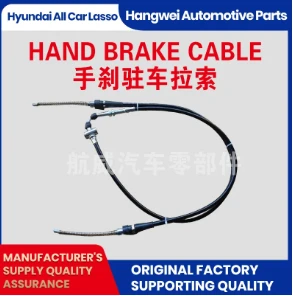Essential Guide to Clutch Slave Cylinder Hose Replacement and Maintenance Tips
Understanding the Clutch Slave Cylinder Hose Its Importance and Maintenance
The clutch system in a vehicle plays a pivotal role in ensuring smooth gear transitions and overall driving comfort. Among the various components that make up this system, the clutch slave cylinder hose is often overlooked, yet it is crucial for effective operation. This article aims to provide insights into what the clutch slave cylinder hose is, its significance, and maintenance tips to ensure optimal performance.
The clutch slave cylinder is part of a hydraulic system that operates the clutch. When the driver presses the clutch pedal, fluid is transferred from the master cylinder to the slave cylinder via the clutch slave cylinder hose. This action disengages the clutch, allowing the driver to shift gears smoothly. The hose serves as the conduit for this hydraulic fluid, delivering the necessary pressure for the slave cylinder to function effectively.
One of the primary reasons why the clutch slave cylinder hose is essential is that it withstands high pressure generated during clutch operation
. The hose is typically composed of high-quality rubber or a combination of rubber and reinforced materials to prevent wear and tear. Over time, however, the hose can become susceptible to cracks, leaks, and other forms of damage due to harsh environmental conditions, high temperatures, and continuous use. A failing hose can lead to loss of hydraulic pressure, making it difficult or impossible to disengage the clutch, which may result in gear shifting problems or even system failure.Regular inspection and maintenance of the clutch slave cylinder hose can help prevent unexpected failures. Vehicle owners should periodically check the hose for signs of wear, such as cracks, bulges, or leaks. A simple visual inspection can often reveal potential issues. If any damage is observed, it is crucial to replace the hose promptly. Ignoring these signs can lead to a failure of the clutch system, which can be costly and inconvenient.
clutch slave cylinder hose

In addition to visual inspections, it is advisable to periodically check the hydraulic fluid level in the clutch system. Low fluid levels can indicate a leak in the hose or other components of the hydraulic system. In this case, it is important not only to replace the hose but also to identify any other underlying issues that may have caused the fluid loss.
Another key aspect of maintaining a healthy clutch slave cylinder hose is ensuring that the connections at both ends of the hose are secure. Loose connections can lead to hydraulic fluid escape, compromising the effectiveness of the system. Tightening these connections while making sure not to over-torque them is critical to maintain the integrity of the system.
When it comes time to replace a worn-out clutch slave cylinder hose, it is essential to choose a high-quality replacement. Using OEM (Original Equipment Manufacturer) parts can ensure compatibility and reliability. Furthermore, professional installation is recommended if you are not adept at automotive repairs, as improper installation can lead to further complications.
In conclusion, the clutch slave cylinder hose is a vital component of the vehicle's clutch system that often goes unnoticed until it fails. Regular maintenance, including inspections for wear and securing connections, can prolong its lifespan and ensure optimal performance. By understanding the role of the clutch slave cylinder hose and taking proactive measures, vehicle owners can avoid potentially significant issues and maintain a smooth and functional driving experience.
-
Upgrade Your Control with Premium Throttle CablesNewsAug.08,2025
-
Stay in Control with Premium Hand Brake CablesNewsAug.08,2025
-
Experience Unmatched Performance with Our Clutch HosesNewsAug.08,2025
-
Ensure Safety and Reliability with Premium Handbrake CablesNewsAug.08,2025
-
Enhance Your Vehicle with High-Performance Clutch LinesNewsAug.08,2025
-
Elevate Your Ride with Premium Gear CablesNewsAug.08,2025
